Something went wrong!
Hang in there while we get back on track
Best attractions in Pisa

The Leaning Tower of Pisa, with its distinctive tilt, is one of the world's most famous landmarks. Construction began in 1173, but by the time the third floor was added in 1185, the tower had already started to lean due to the soft, sandy ground. Originally intended as a freestanding bell tower for the Cathedral of Pisa, its completion was delayed by construction pauses and adjustments, finally finishing in 1372. Today, the tower tilts at about four degrees and draws millions of visitors each year who brave its 294 steps.
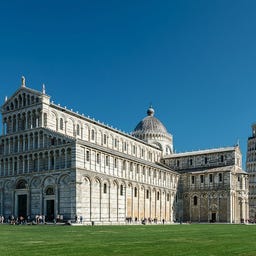
The Cathedral of Pisa, the oldest structure on the Piazza dei Miracoli, was begun in 1064 outside the city's walls to showcase Pisa's confidence against potential attacks. The construction was funded by war booty, notably from a victorious raid on the Saracens in Palermo. This cathedral, along with St. Mark's Basilica, is one of the first monumental buildings of medieval Italy, making it particularly significant in art history. It was built either before or around the same time as the Venetian basilica, during a period when both powerful maritime republics were vying to assert their cultural dominance. The origins of the Persian and Byzantine influences in its design remain unclear.

The Square of Miracles, or Piazza del Duomo, ranks among the world's most stunning plazas. Its centerpiece, the famous Leaning Tower, stands boldly beside the majestic Cathedral with its gleaming white marble facade.
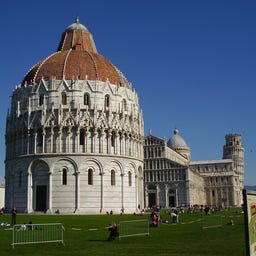
The Baptistery rises like a marble crown on the Piazza dei Miracoli. Begun in 1153 under the direction of Diotisalvi, this remarkable structure combines Romanesque austerity with Gothic elegance. Standing 55 meters tall and over 100 meters in diameter, it is the largest baptistery in the world. Its two distinct dome halves create a stunning play of colors at sunrise and sunset.
Inside, the atmosphere is simple, almost ascetic, drawing the eye to the marble pulpit by Nicola Pisano, a 1260 masterpiece that marks the dawn of the Renaissance. Every half hour, the Baptistery’s acoustic marvel comes to life: its double dome, with an inner pyramid and outer hemisphere, transforms even whispers into something akin to heavenly music.
Also noteworthy is the beautiful octagonal baptismal font, crafted in 1246. Incidentally, construction wasn’t completed until 200 years later, in 1363.
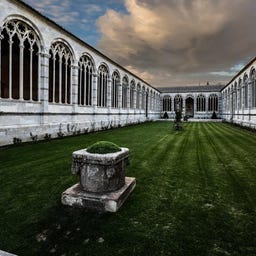
On the edge of the famous Cathedral Square lies the Campo Santo, or Holy Field. This cemetery was partially built with soil from Golgotha, a sacred place believed to cause bodies buried there to decay within 24 hours. Crusaders brought this holy soil back to Italy.

The Palazzo Blu, a former 14th-century noble palace, houses a small art museum. Inside, you'll find a permanent exhibition of Tuscan paintings and antique furniture, along with temporary art exhibitions—including a few pieces by Galileo Galilei. It's an ideal retreat for art lovers looking to escape the crowds and summer heat.
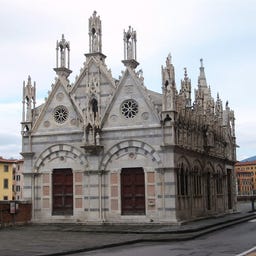
Santa Maria della Spina, a gem of Pisan Gothic architecture, was built in 1230 from white marble. Despite its small size, it impresses with an intricate façade adorned with statues and ornate pinnacles. The church was named "Spina" because it originally housed a thorn from Christ’s Crown of Thorns.
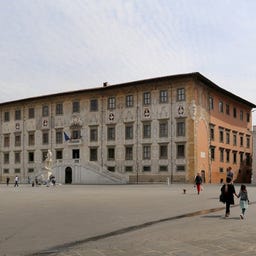
On the way to the Leaning Tower of Pisa, this photogenic square is worth a detour. Once the city's political and administrative heart, it’s now a showcase of Renaissance architecture. Impressive buildings like the Church of Santo Stefano dei Cavalieri and the Palazzo della Carovana, former seat of the Order of the Knights of Santo Stefano, surround the square. The Palazzo's facade, adorned with intricate sgraffito decorations and busts of Roman Grand Masters, whispers stories of the past.
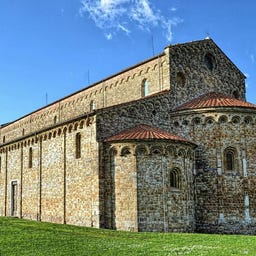
Just a few kilometers from Pisa, you will find the Basilica di San Pietro Apostolo, a fascinating example of Pisan-Romanesque architecture from the 10th century. The church is notable for its unusual design featuring two opposing apses and the absence of a traditional façade, a result of its tumultuous history dating back to the 4th century.
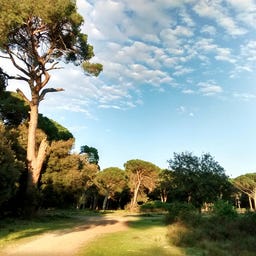
In the Tuscan Parco naturale di Migliarino, you can expect a fascinating mosaic of coastal landscapes, forests, and wetlands that spans over 23,000 hectares. This protected natural paradise, established in 1979, is home to an impressive variety of wildlife and rare plant species, including sundew and hibiscus.
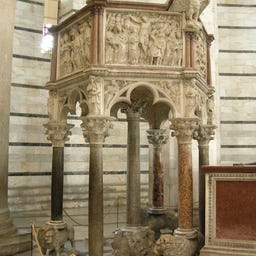
The marble pulpit in the Baptistery of Pisa, crafted by Niccolò Pisano in 1260, is considered a masterpiece of the Proto-Renaissance. The hexagonal basin is supported by seven columns, three of which rest on intricately carved lions. The parapet features five detailed reliefs depicting New Testament scenes, including the Annunciation, Nativity, and Last Judgment. This work is particularly notable for its blend of classical influences with Gothic elements, marking a pivotal moment in the evolution of European sculpture.
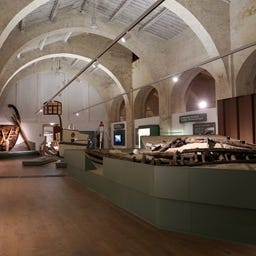
In the historic Arsenali Medicei of Pisa, you can explore a fascinating archaeological museum that brings the history of ancient seafaring to life across 8,000 square meters. The spectacular discovery of over 30 ancient ships dating from the 2nd century BC to the 7th century AD, found during construction work at the San Rossore train station in 1998, is the centerpiece of the exhibition.
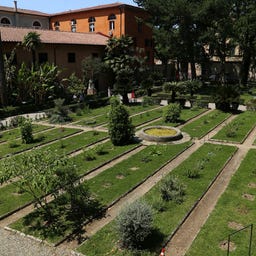
In the oldest active botanical garden in the world, you walk through nearly 500 years of scientific history: the Orto e Museo Botanico di Pisa was founded in 1543 by Luca Ghini with the support of the Medici and now hosts over 2,000 plant species across three hectares.
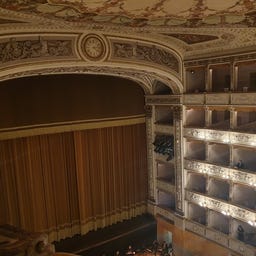
At the Teatro Verdi, the most important theater in Pisa, you can experience one of the most significant examples of 19th-century Italian theater architecture. Opened in 1867, the theater impresses with its grand stage, which is 26 meters deep and 32 meters wide—one of the largest in Italy—as well as its colorful, elegantly restored interior.
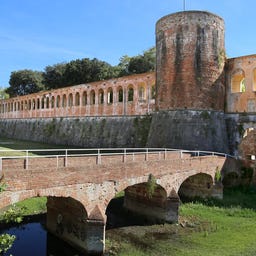
The fortress known today as Giardino Scotto on the southern bank of the Arno was built starting in 1440 by the famous architects Filippo Brunelleschi and Giuliano da Sangallo. It is considered one of the first Italian fortifications specifically designed for the use of gunpowder.

In the historic old town of Pisa stands the Chiesa di Santa Caterina d'Alessandria, whose impressive Gothic facade, featuring a double loggia and a rose window framed by 22 busts of saints, is among the most beautiful in the city. Founded by Uguccione Sardo in 1220, this Dominican church took on its current form after a major renovation that was completed in 1326.
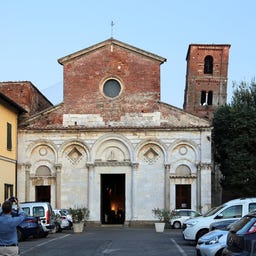
East of the city center of Pisa, you will find the remarkable Chiesa di San Michele degli Scalzi, a church from the early 13th century, whose leaning bell tower at a 5-degree angle even surpasses the famous Leaning Tower of Pisa.
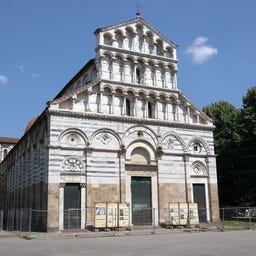
The Chiesa di San Paolo a Ripa d'Arno, also known as the "old cathedral" of Pisa, has impressively stood on the banks of the Lungarno since the 9th or 10th century. The Romanesque church was expanded in the 12th century based on the model of the Cathedral of Pisa and was consecrated by Pope Eugene III in 1149.
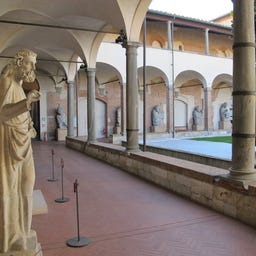
The Cathedral Museum in Pisa houses a beautifully curated collection of sacred artworks and artifacts that reflect the rich artistic heritage of the buildings on the Piazza dei Miracoli. Definitely worth a visit with the combo ticket. Notable highlights include the sculptures by Giovanni Pisano and the medieval bronze cross from France. The museum opened in 1986 and offers a comprehensive insight into the religious and artistic significance of Pisa during the Middle Ages and the Renaissance.
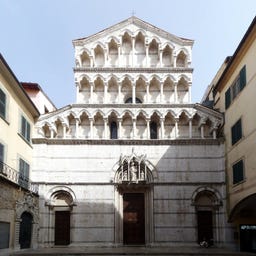
In the picturesque old town of Pisa, you will find the Chiesa di San Michele in Borgo, an impressive church from the early 11th century dedicated to the Archangel Michael. The Romanesque facade from the 13th-14th centuries harmoniously blends with Gothic elements, while the three-nave interior still retains original features from the 11th-12th centuries. Notable highlights include the magnificent marble altar from the 17th century and the valuable paintings by Matteo Rosselli and Aurelio Lomi. After suffering severe damage during World War II, the church was carefully restored, although the original monastery complex was unfortunately lost.
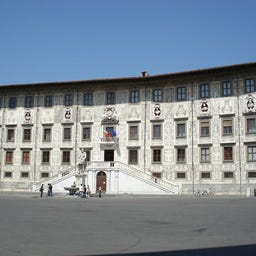
The palace, known as the Palazzo dei Cavalieri, is a magnificent example of Renaissance architecture. Designed by Master Architect Giorgio Vasari and built between 1562 and 1564, it once served as the headquarters of the Order of the Knights of Saint Stephen. The building's elegant facade—decorated with marble busts and sgraffiti depicting astrological symbols and allegories—reflects the power and legacy of the Medici dynasty. A grand central staircase, renovated in 1821, enhances its monumental effect.
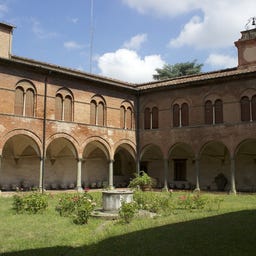
The underrated National Museum of San Matteo, often overlooked by tourists, holds one of Italy’s most significant collections of medieval art, spanning from the 12th century to the Renaissance. The museum showcases Christian artworks, ceramics, and exquisite illuminated manuscripts by renowned artists like Beato Angelico, Simone Martini, Masaccio, Domenico Ghirlandaio, and Donatello.

The Chiesa di San Nicola combines Romanesque and Baroque architecture and impresses with its distinctive octagonal bell tower, which, like its famous neighbor, is slightly tilted. The church, mentioned as early as 1097, was expanded by the Augustinians in the 13th century and now houses significant art treasures, including works by Giovanni Pisano and a Madonna by Francesco Traini from the 14th century.
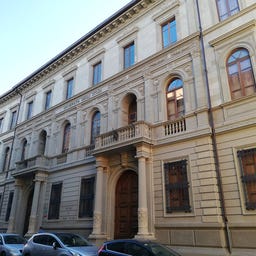
In the heart of Pisa stands the Palazzo della Sapienza, an impressive Renaissance building that was started by Lorenzo de' Medici in 1486 and completed by Cosimo I in 1543. This trapezoidal structure, with its symmetrical colonnade, now houses the law faculty and the university library of the University of Pisa.
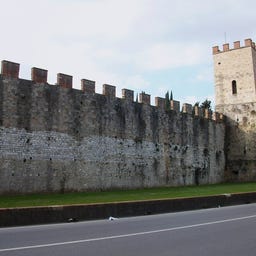
The city walls, built in the 12th century, offer a 3 km route with stunning elevated views of Pisa. From the well-preserved walls, you can take in the city’s sights while escaping the crowds.
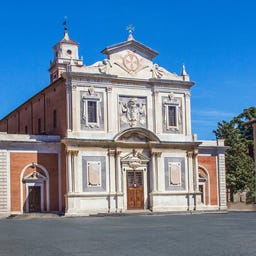
The magnificent Chiesa di Santo Stefano dei Cavalieri in the historic center of Pisa is an impressive testament to 16th-century Tuscan church architecture. Designed by Giorgio Vasari, the building was commissioned in 1565 by Cosimo I de' Medici for the Order of Santo Stefano and captivates with its striking facade made of white Carrara marble.

The elegant Ponte di Mezzo serves as the central bridge of Pisa, connecting Piazza Garibaldi with Piazza XX Settembre and spanning the Arno with a single 72-meter arch. Built from white Veronese stone and porphyry, this structure was completed in 1950 after the destruction of its predecessor during World War II and is considered a symbol of the city's reconstruction.
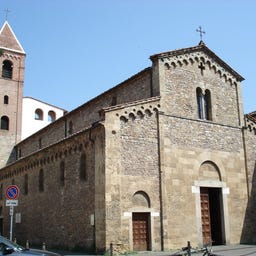
The Chiesa di San Sisto is one of the most significant Romanesque churches in Pisa, built between 1087 and 1133 in honor of the city's patron saint. Inside, you will find three naves featuring original Roman column capitals and valuable artworks, including a wooden crucifix from the 14th century and the "Madonna della Purità" from the late 13th century. The distinctive three-part façade is adorned with replicas of Islamic ceramic basins from the 11th to 12th centuries, while the originals can be admired today at the Museo di San Matteo. Despite several restorations, the church has retained its medieval character and remains a vibrant place, especially on August 6th, when a solemn ceremony is held to honor the fallen soldiers of Pisa.
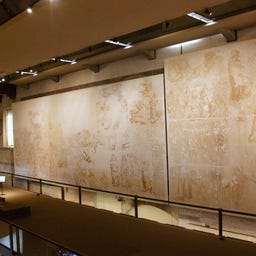
This building at the Duomo Square serves as the ticket office for the main attractions in Pisa. However, it is also a museum in its own right. Inside, you'll find a unique collection of preliminary drawings for frescoes that once graced the walls of the Camposanto Monumentale. The museum is particularly appealing to those with an interest in art history.
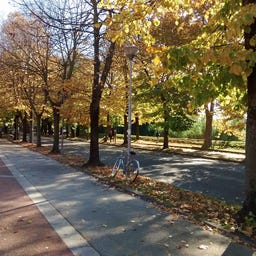
Along the Arno stretches the Viale delle Piagge, a two-kilometer-long avenue that rises five meters above the river, lined with linden trees, plane trees, and cork oaks. This popular walking and cycling path was created in the mid-19th century by Angiolo Pera and today offers a beloved recreational space for locals and visitors alike, featuring pink granite benches, historic drinking fountains, and fitness equipment.
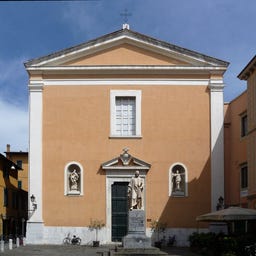
The Chiesa di Santa Maria del Carmine, built by Carmelites in the early 14th century, combines Renaissance and Baroque elements under an impressive wooden roof. The magnificent Baroque altars and the imposing organ by Andrea Ravani from 1613 reflect the wealth that has grown over centuries within the church.
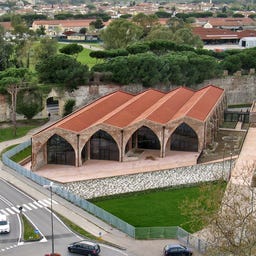
In the powerful Arsenals of the Republic of Pisa, you can experience a fascinating piece of maritime history: Here, starting from the 12th century, the galleys of the Pisan Republic were built and maintained. The shipyard, once protected by walls and towers, lost its military significance in the mid-16th century and was heavily damaged during World War II. After an extensive restoration in 2015, the partially reconstructed complex now hosts temporary exhibitions and is part of the Museum of Ancient Ships of Pisa. The site is named in honor of the archaeologist Khaled al-Assad, who was killed in 2015 while defending cultural heritage from ISIS.
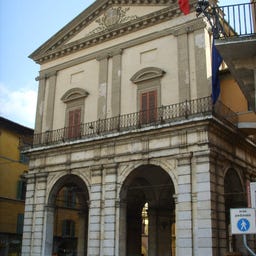
The striking Logge di Banchi greets you at the southern end of the Ponte di Mezzo as one of the most characteristic buildings along Pisa's waterfront. This arcade structure, supported by twelve columns, was built in the early 17th century by architect Bernardo Buontalenti and originally served as a marketplace for wool and silk.
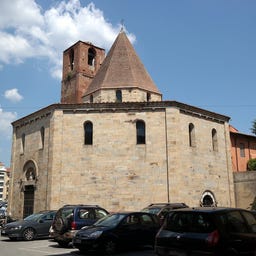
The octagonal Chiesa del Santo Sepolcro from the 12th century is a fascinating example of the architectural influences of the Crusades in Pisa. The construction, initiated by Archbishop Daiberto, was built after the model of holy sites in Jerusalem and originally served as a church, hospital, and inn for the Knights Hospitaller.
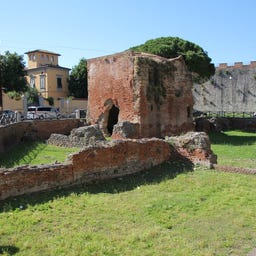
In the Bagni di Nerone, you will find the only publicly accessible monument from the Roman era in Pisa, built in the late 1st century under Emperor Domitian as a monumental thermal complex. The octagonal hot bath with its partially preserved dome, along with the remains of the training arena and the warm bath, still testify to the former splendor of the facility, which sourced its water from the nearby Auser River via an aqueduct.
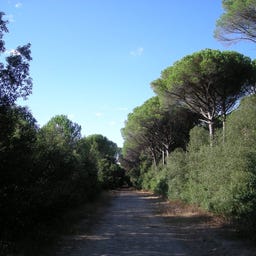
In the protected nature area Tenuta di Tombolo, you will find a 5,000-hectare expanse along the Tuscan coast, characterized by dense forests and agricultural land.
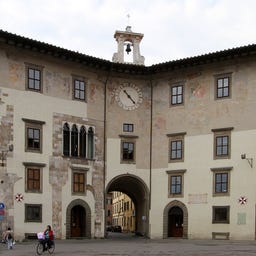
The majestic Palazzo dell'Orologio at the Pisan Piazza dei Cavalieri uniquely combines medieval history with Renaissance architecture. Within its walls lies the famous Torre della Muda, where the tragic fate of Count Ugolino della Gherardesca unfolded in 1289—a story later immortalized by Dante in his "Divine Comedy."
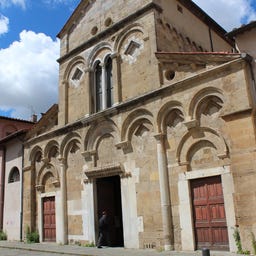
The Chiesa di San Frediano in Pisa has a rich history that dates back to the 11th century when it was originally dedicated to Saint Martin of Tours. With its distinctive Pisan-Romanesque architecture, it impresses with an imposing façade, three naves, and eight intricately designed side chapels, which house a 12th-century crucifix and a statue of Mary from the late 17th century, among other treasures.

The Porta a Lucca is one of the historical city gates of the Pisa city wall and was built in the 16th century under Florentine rule. The medieval archway received a double sandstone frame in the 17th century and features two side passages for pedestrians.
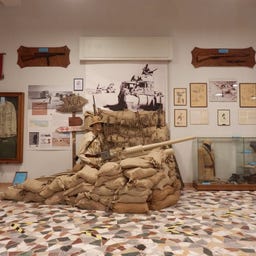
In the Historical Museum of Airborne Troops in Pisa, you can embark on a comprehensive journey through the history of Italian paratroopers across 800 square meters. The 15 exhibition rooms, arranged chronologically, house around 3,000 exhibits, including weapons, badges, and historical documents from the inception of parachuting to the present day.
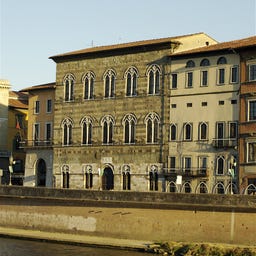
The impressive Palazzo Gambacorti on the Lungarno in Pisa combines medieval splendor with vibrant modernity - since the 15th century, the palace has served as the seat of the city administration. Built between 1370 and 1392 by Pietro Gambacorti, the structure captivates with its Gothic facade featuring a black-and-white pattern and elegant bifore windows.
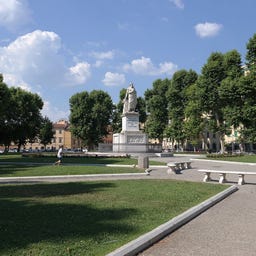
On the expansive Piazza Martiri della libertà, located near the Church of Santa Caterina d'Alessandria, you will find one of the most beautiful squares in Pisa from the early 19th century. Where a monastery once stood, an elegant green space with avenues and marble benches was developed after 1815, based on the designs of Tommaso Poschi and Alessandro Gherardesca.
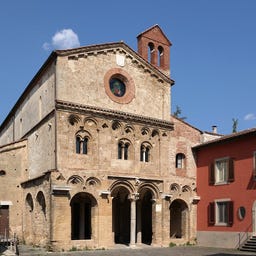
The Chiesa di San Zeno at the northeastern edge of Pisa's city center has a history that spans almost 1000 years, with its first mentions dating back to 1029. The three-nave church was built on the remains of a Roman amphitheater, which is why the area was known in the Middle Ages as "alle grotte" (by the grottos).
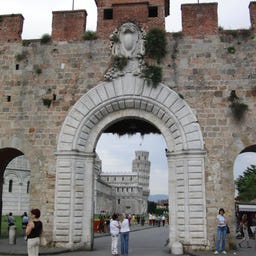
The Porta Nuova, one of the newer city gates in Pisa's historic city wall, was opened in 1562 by Cosimo I de' Medici and today serves as one of the main entrances to the famous Piazza dei Miracoli.
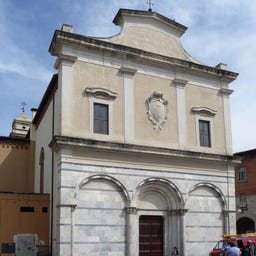
The Chiesa di Sant'Antonio Abate fascinatingly combines medieval architecture with contemporary art: While the characteristic two-tone marble facade from the early 15th century was created by Lupo di Gante and his colleagues, you can find the famous "Tuttomondo" mural on the exterior wall - the last public work of artist Keith Haring before his death in 1990.
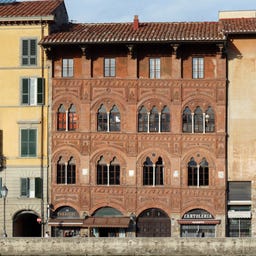
With its distinctive red terracotta facade, the Palazzo Agostini has shaped the skyline along the Lungarno in Pisa since the 14th century. This Gothic building houses the historic Caffè dell'Ussero, which has served as a cultural meeting point since 1775, where notable figures like Giosuè Carducci gathered.

At the entrance to the famous Piazza dei Miracoli, you will find the impressive Fontana dei Putti, a monumental fountain made of white Carrara marble. Created between 1746 and 1765 by Giuseppe Vaccà and Giovanni Antonio Cybei, the fountain features three life-sized putti playfully holding up the coats of arms of Pisa and the Opera del Duomo.
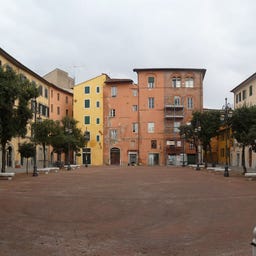
On the lively Piazza Chiara Gambacorti, named after the blessed woman from the influential Gambacorti family, you can find cozy restaurants and bars today.

On the Lungarno Mediceo stands the impressive Palazzo Medici, whose history dates back to the 11th century and which now serves as the Prefecture of Pisa. Originally known as Palazzo Appiano, the building took on its distinctive shape in the 13th century and came into the possession of the Medici family in 1446.

As the second largest church in Pisa after the Cathedral, the Chiesa di San Francesco impresses with its massive nave, which is 18 meters wide. Built in the 13th century by Giovanni di Simone, the church features a marble facade that combines elements from the 13th and 17th centuries and houses the tomb of Count Ugolino della Gherardesca, immortalized by Dante.

The Piazza Garibaldi in the heart of Pisa is more than just a historic square at the foot of the Ponte di Mezzo. Since 1892, the bronze statue of Giuseppe Garibaldi, created by Ettore Ferrari, stands here, showcasing impressive reliefs that depict important moments in the life of the Italian freedom fighter.
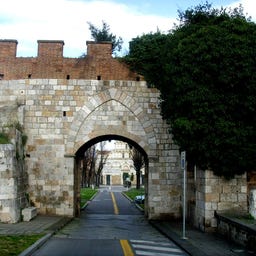
At the historic Porta a Mare, part of the old city wall of Pisa, you discover an impressive testament to medieval fortification from the 12th and 14th centuries. Here, you’ll find not only an ornate marble tabernacle from the 18th century featuring the "Madonna dei Navicellai," but also the magnificent Romanesque church San Paolo a Ripa d'Arno.
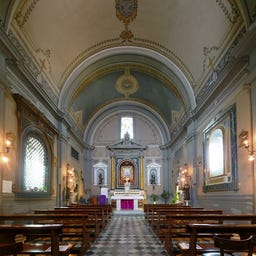
Just a few steps from the Piazza del Duomo, you will find the Chiesa di Santa Chiara, which was built in the 13th century as a hospital church. This simple sacred building houses some remarkable art treasures, including a relic of Christ's crown of thorns from Santa Maria della Spina and an intricate marble Annunciation by Stoldo Lorenzi from 1567. Inside, you can also admire a wooden crucifix from the 14th/15th century and a fresco of the Madonna with Child, which was added during renovations in the 17th century. In the courtyard, you can still see remnants of the original church structure from the 13th century.
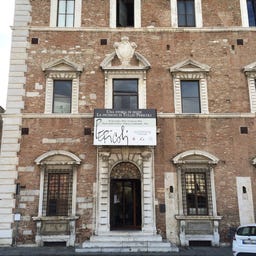
The impressive Palazzo Lanfranchi on Lungarno Galilei combines the structures of four medieval buildings from the 13th century, which were transformed into an elegant city palace between 1535 and 1539.
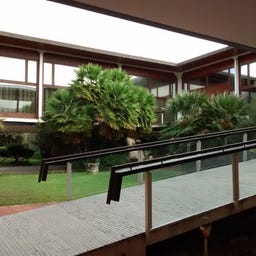
In the expansive natural landscape of the Migliarino-San Rossore-Massaciuccoli Park near Pisa, the Villa del Gombo rises elegantly on steel supports above the ground. This modern building, designed by architects Amedeo Luccichenti and Vincenzo Monaco in the late 1950s, replaces a dilapidated hunting lodge of the House of Savoy and was built as the presidential residence of the Italian Republic. With its 640 m² footprint, extensive glass surfaces, and a central square courtyard, the villa harmoniously integrates into an ambitious environmental project that includes 350,000 plants and vast green spaces. Today, the building, managed by the Tuscany region, serves as a venue for conferences and cultural events.

The octagonal Cappella di Sant'Agata, built by Vallombrosan monks in the 12th century, is dedicated to the patron saint of Catania. With its distinctive brick construction, decorative pilasters, and pyramid-shaped roof, it resembles the Holy Sepulchre and was likely designed by the architect Diotisalvi.
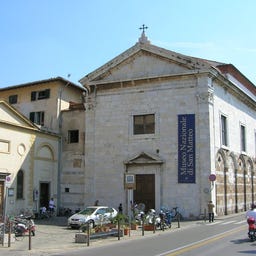
In the Chiesa e convento di San Matteo, founded in 1027 by Ildeberto degli Albizi and his wife Donna Teuta as a Benedictine monastery, you can expect a fascinating journey through nearly a millennium of Pisan history.
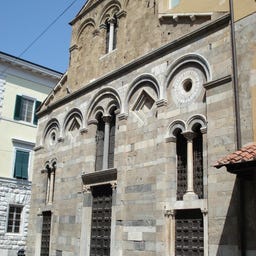
The Chiesa di San Pietro in Vinculis is one of the oldest churches in Pisa, with its first mention dating back to 763. The current Romanesque structure, consecrated in 1118, impresses with its distinctive facade made of Verrucana stone, featuring three portals and a central bifora.
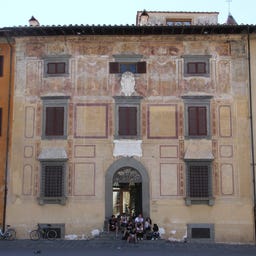
The Palazzo del Collegio Puteano at the Piazza dei Cavalieri impressively combines history and the present. Built at the end of the 16th century from several older houses, the Palazzo housed students of the University of Pisa for over 300 years and became the student residence of the Scuola Normale in 1930 after a brief closure.
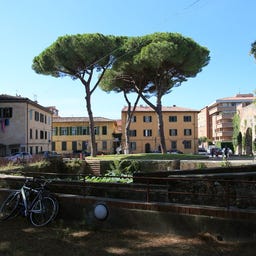
Located at the medieval city wall of Pisa, the Piazza delle Gondole was once a bustling little harbor fed by a passage in the wall from the Serchio River. The historic water basin, known as the "Porto delle Gondole," served as a docking point for boats that brought visitors to the Bagni di Pisa for thermal treatments.
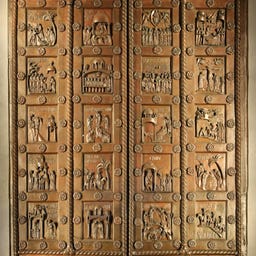
The bronze Porta di San Ranieri, created by Bonanno Pisano in the late 12th century, is one of the few surviving masterpieces of the artist. The 24 intricately designed bronze panels depict scenes from the New Testament and blend classical with Byzantine stylistic influences.
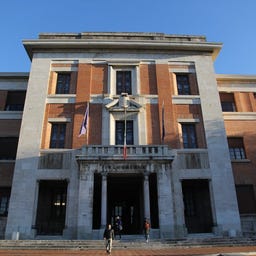
The impressive Scuola Reale di Ingegneria in Pisa, which is now home to the Faculty of Engineering, was ceremoniously inaugurated in 1936 in the presence of King Vittorio Emanuele III. The symmetrical building, designed in a rationalist style, stands out with its striking three-part façade made of travertine and brick, as well as a semi-circular monumental staircase that connects the two square main buildings.

In Via San Michele degli Scalzi, you will find the Chiesa dei Santi Jacopo e Filippo, a historic church also known as San Jacopo in Orticaia. This former Augustinian establishment, documented since 1110, impresses with its unfinished façade featuring a Roman marble architrave.

In the Domus Mazziniana, the Italian freedom fighter Giuseppe Mazzini spent his last weeks in 1872 under the pseudonym Giorgio Brown. The building, rebuilt after World War II, now houses a fascinating museum dedicated to the Italian Risorgimento, featuring three exhibition rooms and an extensive library.
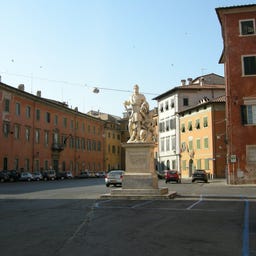
At Lungarno Pacinotti, you will find one of the oldest squares in Pisa, Piazza Carrara, which was formerly known as Piazza San Nicola after the adjacent church. In the center stands the white marble statue of Grand Duke Ferdinando I de' Medici, created by Pietro Francavilla based on a design by Giambologna, and moved to its current location in 1872.
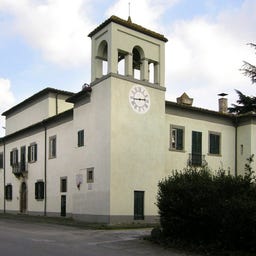
Hidden behind tall trees in the green estate of Coltano, you discover an impressive Medici villa from the 16th century, resembling a small fortress with its four corner towers.
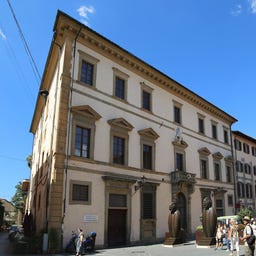
In the historic center of Pisa stands the impressive Palazzo Boilleau from the late 16th century, which, with its three-story façade and distinctive central portico, is one of the most significant Renaissance buildings in the city. Designed by architect Raffaello Zanobi di Pagno, the palace was commissioned by Carlo Antonio Dal Pozzo, an advisor to Grand Duke Ferdinando I de' Medici, and features a bust created by Pietro Francavilla above the entrance portal.
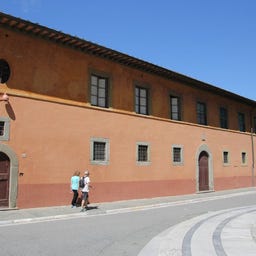
The Palazzo dell'Opera della Primaziale Pisana, built in the early 14th century at the northern edge of the Campo Santo, originally served as a residence for the craftsmen and staff of the cathedral. Inside, you can find a rare Byzantine fresco of the "Madonna and Child," impressive stucco work by Angelo Somazzi and Giuseppe Ferri, as well as 18th-century frescoes.
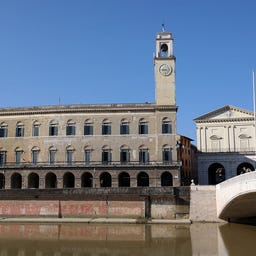
On Lungarno Galilei, not far from the Logge di Banchi and the Ponte di Mezzo, stands the impressive Palazzo Pretorio, which has a rich history as the seat of the governor. After an architectural competition in the early 19th century, Alessandro Gherardesca transformed the medieval building into a neoclassical palace with an open colonnade.
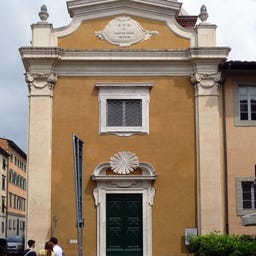
In the Church and Convent of Sant'Anna, you can expect to see an impressive church from the early 15th century, which was completely redesigned between 1741 and 1747 by architects Giuseppe and Francesco Melani.
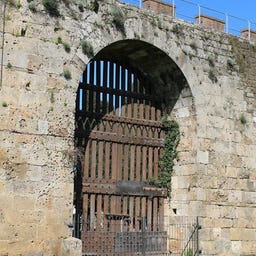
The Porta del Leone at the edge of the Piazza del Duomo is one of the most significant medieval city gates of Pisa from the 12th century. In a niche, a marble lion of Etruscan origin sits, which was once considered the protector of the city and was turned inward as a statement during Florentine rule. This impressive gate was once the entrance for high-ranking individuals to the city's religious center, until the Florentines created a new main access with the Porta Nuova. Today, you can find this historic gate, which is also closely linked to the history of Pisa's Jewish community, in a small, quiet square beyond the Camposanto.
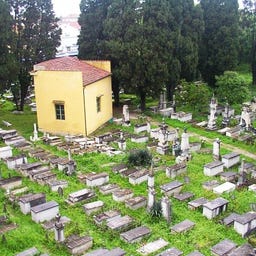
Right next to the famous Piazza del Duomo, you will find the historic Jewish cemetery of Pisa, which has been located here since the second half of the 17th century. The Grand Duke of Tuscany had given the land to the Jewish community in exchange for the previous cemetery.

In the northeastern corner of Pisa, you will find the Chiesa e convento di Santa Croce in Fossabanda, a historic church from the 14th century, named after an old drainage ditch. The single-nave church houses remarkable artworks, including a Madonna by Álvaro Pires d'Evora from the 15th century and a valuable wooden cross from the same period.
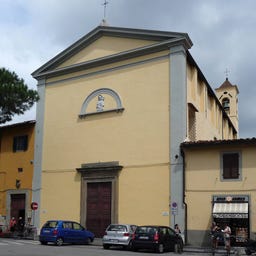
The Church and Convent of San Torpé, located opposite the ruins of the Terme di Nerone, is one of the historically significant sacred buildings in Pisa. Originally founded in the 13th century by the Umiliati, the church transitioned to the Order of the Minims in the 16th century and underwent extensive restoration in the 17th century.
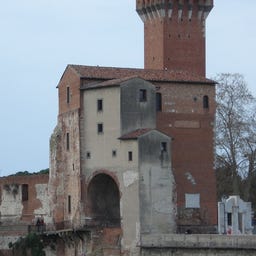
The impressive Cittadella di Pisa at the northern end of the city walls still stands as a testament to the former military and shipbuilding power of the Tuscan trading republic. From the distinctive Torre Guelfa, built as a watchtower in the late 13th century, you can enjoy a wide view over Pisa and the Arno. The fortress, which took on its current form under Florentine rule starting in 1406, houses restored remnants of the republican shipyards from the 13th century. Rebuilt after severe war damage in 1944, you can now explore the historic walls during special events and learn more about the tradition of the Gioco del Ponte in the small museum.

As a prominent watchtower of the Cittadella di Pisa, the Torre Guelfa offers you an impressive panoramic view of the city all the way to the sea. Built in the early 15th century during Florentine rule, the tower was destroyed in World War II and faithfully reconstructed in 1956.
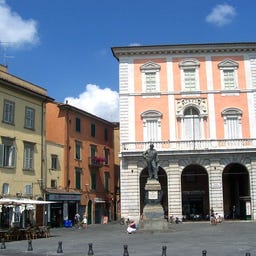
In the heart of Pisa stands the Casino dei Nobili, an elegant 18th-century building that offers you an impressive view of the Piazza Garibaldi and the Borgo Stretto from via Notari. Its architecture combines various eras, with particularly fascinating remnants of an 11th-century tower still visible, including a characteristic arch and a low portal. The magnificent façade is dominated by a columned portico on the ground floor and features a continuous balustrade terrace on the first floor, while three intricately designed windows with triangular and round pediments adorn the top floor.
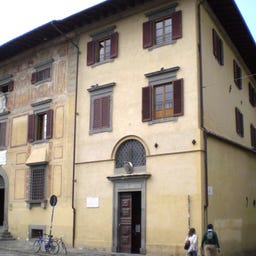
The nearly 1000-year-old Chiesa di San Rocco at the Pisan Piazza dei Cavalieri houses artistic treasures from several centuries under one roof. Inside, you will find impressive wall decorations from the 13th and 18th centuries, including a fresco by Francesco Venturi depicting Saint Rocco healing plague victims. Particularly valuable are the wooden "Volto Santo" statue from the 13th century and a colored Madonna with Child made of terracotta from the 15th century. The church acquired its current appearance through extensive renovations in the 17th century, funded by grateful Pisan families after the end of a plague epidemic.
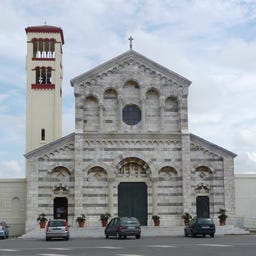
The Chiesa di Santa Maria Ausiliatrice has shaped the skyline of Marina di Pisa since its inauguration in 1916, where it majestically overlooks the square of the same name. Commissioned by Cardinal Maffi, the church impresses with its neo-Romanesque style, which is clearly inspired by Pisan Romanesque architecture.
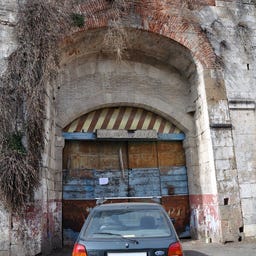
The Porta del Parlascio is one of the two most important city gates of the historic Mura di Pisa, built in 1157. As one of the few decorated gates in the city wall, it provided direct access to both the Piazza del Duomo and the political center of the city.
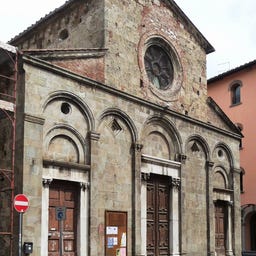
The Chiesa di Sant'Andrea Forisportam is one of the historically most significant churches in Pisa and was first mentioned in documents in 1104. With its distinctive façade featuring three portals and five blind arches, it combines Islamic influences with the typical Pisan architecture of the Middle Ages.

In the heart of Pisa's historic center, you discover the Piazza delle Vettovaglie, a vibrant marketplace from the 16th century, originally established for grain trade under Cosimo I de' Medici between 1544 and 1545.
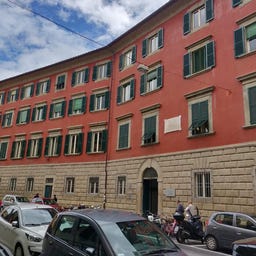
In the historic center of Pisa, you will find the Palazzo Venera, an impressive 18th-century building with origins dating back to the Middle Ages. The four-story facade, featuring a rustic ground floor and intricately painted vaults on the first floor, showcases the architectural significance of the Palazzo, which now belongs to the University of Pisa.
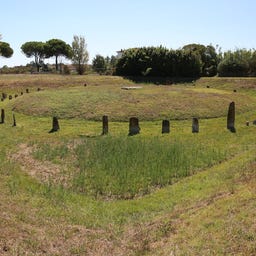
In the northwestern area of Pisa, you can discover the impressive Tumulo del Principe etrusco, a burial monument from the 7th century BC that was accidentally uncovered during well drilling in 1967. This grand burial mound, with its distinctive stone crown, belonged to a significant Etruscan family and offers you fascinating insights into the burial rituals of this mysterious culture. What’s particularly interesting is that, although no human remains were found, the recovered artifacts—including a trident symbolizing power—suggest a close connection between those buried here and the sea.
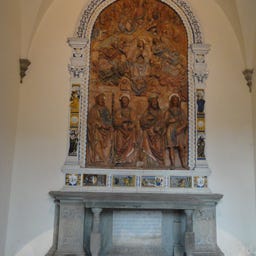
In the north wall of the famous Camposanto Monumentale in Pisa, you will find the Cappella Aulla, whose history dates back to the Church of San Marco in Calcesana. The highlight of the chapel is a magnificent altarpiece by Giovanni della Robbia from 1518, depicting the "Ascension among Saints and Prophets" in glazed and gilded form.
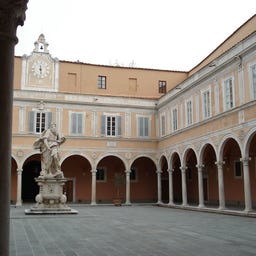
The "Archbishop's Palace" of Pisa is located just after the eastern end of the Cathedral Square, in Piazza dell'Arcivescovado.
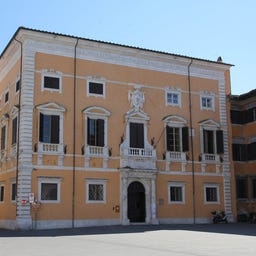
On the historic Piazza dei Cavalieri in Pisa, the Palazzo del Consiglio dei Dodici stands with its distinctive pink facade and white marble decorations. Originally a medieval building, it was extensively renovated at the end of the 16th century by Pietro Francavilla and took on its current form under the Medici.
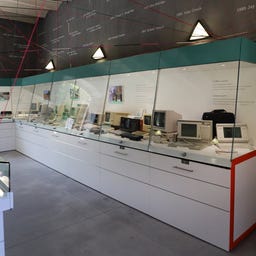
The "Museum of Calculation Instruments" is located in the center of Pisa, in the area of the former slaughterhouses. It is part of the University of Pisa's Museum System and is co-managed by the Galileo Galilei Foundation.

The Sinagoga di Pisa has been a testament to the city's significant Jewish history since the early 17th century. The building, redesigned by Marco Treves in 1863, impresses with its neoclassical facade featuring arched windows and a striking triangular pediment. Inside, you will find a square hall with intricately stuccoed walls, a wooden Tevà, and a marble Torah ark flanked by Corinthian columns. After suffering severe lightning damage in 2007, the synagogue was meticulously restored and has been serving as a spiritual center for the region's Jewish communities since its reopening in 2015.
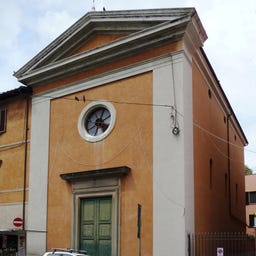
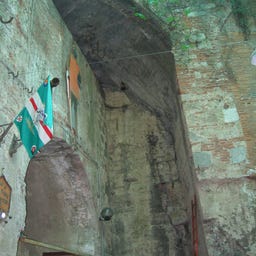
The "Stampace Bastion" is a fortification of the walls of Pisa, designed as an external angular reinforcement of the southwest corner, in the area of Porta a Mare.
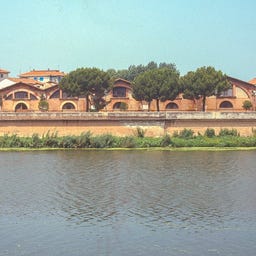
The "Medicean Arsenals" are a group of 16th-century buildings dedicated to shipbuilding. They are located along the Pisa waterfront, in Tuscany.
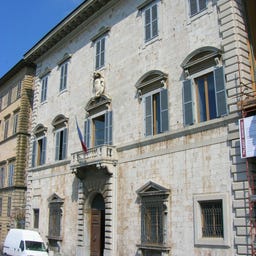
On the Lungarno Mediceo stands the Palazzo Toscanelli, a historic building from the early 16th century that now houses the State Archive of Pisa. Originally built by the Lanfranchi family, the palace was extensively renovated in the 19th century by architect Alessandro Gherardesca, acquiring its current neoclassical appearance.
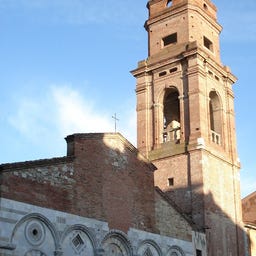
The Chiesa di San Paolo all'Orto in the historic San Francesco district of Pisa impresses with its distinctive two-toned marble facade from the late 12th century, crafted by the sculptor Biduino with intricate arcades and capitals. Inside, you can find well-preserved frescoes from the 12th and 13th centuries, as well as magnificent stucco work from the 18th century.
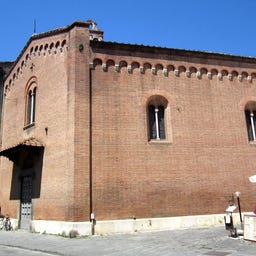
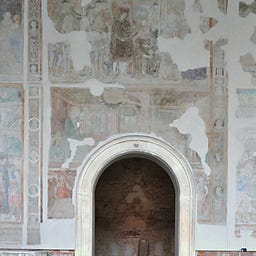
The "Ammannati Chapel" belongs to the monumental Camposanto of Pisa. It is located along the north wall, on the left side, and is directly adjacent to the west door, located on the south side, which is usually closed.
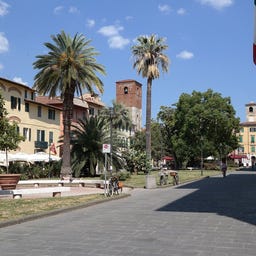
In the heart of the medieval district of Santa Maria, you’ll find the green oasis of Piazza Dante, which was known as "Piazza del Grano" until the early 20th century. The square, characterized by palm trees and a striking cactus, invites you to relax on its curved benches and is now a popular meeting spot for students and visitors.
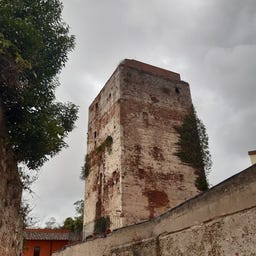
The "Tower of Sant'Agnese," also known as "the Ghibellina," is located in Pisa along the ancient walls near via Nicola Pisano.
